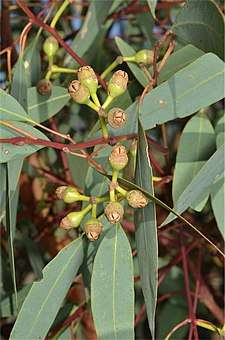Eucalyptus ammophila
Eucalyptus ammophila, commonly known as the sandplain red gum,[3] is a mallee that is endemic to central and southern Queensland. It has rough fibrous bark near the base and smooth greyish and orange to bronze bark higher up. It has lance-shaped leaves, yellow or creamy flower buds in groups of between seven and eleven, white flowers and hemispherical fruit with strongly raised valves.

| Sandplain red gum | |
|---|---|
 | |
| Eucalyptus ammophila growing near Aramac | |
| Scientific classification | |
| Kingdom: | Plantae |
| Clade: | Tracheophytes |
| Clade: | Angiosperms |
| Clade: | Eudicots |
| Clade: | Rosids |
| Order: | Myrtales |
| Family: | Myrtaceae |
| Genus: | Eucalyptus |
| Species: | E. ammophila |
| Binomial name | |
| Eucalyptus ammophila | |
Description
Eucalyptus ammophila is a mallee that grows to 6 m (20 ft) high, rarely a small, multistemmed tree, and forms a lignotuber. The trunk has rough, fibrous, greyish brown bark and the upper parts of the trunk and the branches have smooth greyish and orange to bronze-coloured bark. Young plants and coppice regrowth have square stems and broad lance-shaped to egg-shaped leaves that are 60–85 mm (2.4–3.3 in) long and 22–36 mm (0.87–1.4 in) wide with a short petiole. Adult leaves are lance-shaped, 65–135 mm (2.6–5.3 in) long and 15–25 mm (0.59–0.98 in) wide with a petiole 7–25 mm (0.28–0.98 in) long. Both sides of the leaf are the same dull green, although bluish green at first.[2][4]
The flowers are arranged in groups of between seven and eleven in leaf axils on a peduncle 5–12 mm (0.2–0.5 in) long, each flower on a pedicel about 2 mm (0.08 in) long. The mature flower buds are oval to spindle-shaped, yellow or cream-coloured, 8–9 mm (0.3–0.4 in) long and about 5 mm (0.2 in) wide. The operculum is cone-shaped and about 6 mm (0.2 in) long. The fruit is a hemispherical capsule 3–5 mm (0.12–0.20 in) long and 6–9 mm (0.24–0.35 in) wide with the four, sometimes five, strongly raised valves.[2][4]
Taxonomy and naming
Eucalyptus ammophila was first formally described in 1994 by Ian Brooker and Andrew Slee from a specimen collected in the Maranoa region of Queensland, and the description was published in the journal Austrobaileya.[1][2] According to Brooker and Slee, the specific epithet (ammophila) is derived from the Greek ammos, "sand" and phila "loving" referring to this species' preference for growing on sandplains.[2][4] In ancient Greek, "loving" is however philos (φίλος) (masculine) or philē (φίλη) (feminine).[5]
Distribution and habitat
The sandplain red gum grows on red or orange sandplains in central and southern Queensland, including areas near Charleville, Yalleroi Jericho and the White Mountains.[4]
See also
References
- "Eucalyptus ammophila". Australian Plant Name Index (APNI), IBIS database. Centre for Plant Biodiversity Research, Australian Government. Retrieved 20 November 2018.
- Brooker, M.I.H. & Slee, A.V. (1994) A new species of redgum (Eucalyptus subser. Phaeoxyla Blakely) from central and southern Queensland. Austrobaileya 4(2): 265-267, Figs 1, 2, Map 1. Retrieved 20 November 2018.
- "Sandplain red gum – Eucalyptus ammophila". WetlandInfo. Queensland Government. Retrieved 23 October 2016.
- "Eucalyptus ammophila". Centre for Australian National Biodiversity Research. Retrieved 23 February 2019.
- Liddell, H.G. & Scott, R. (1940). A Greek-English Lexicon. revised and augmented throughout by Sir Henry Stuart Jones. with the assistance of. Roderick McKenzie. Oxford: Clarendon Press.